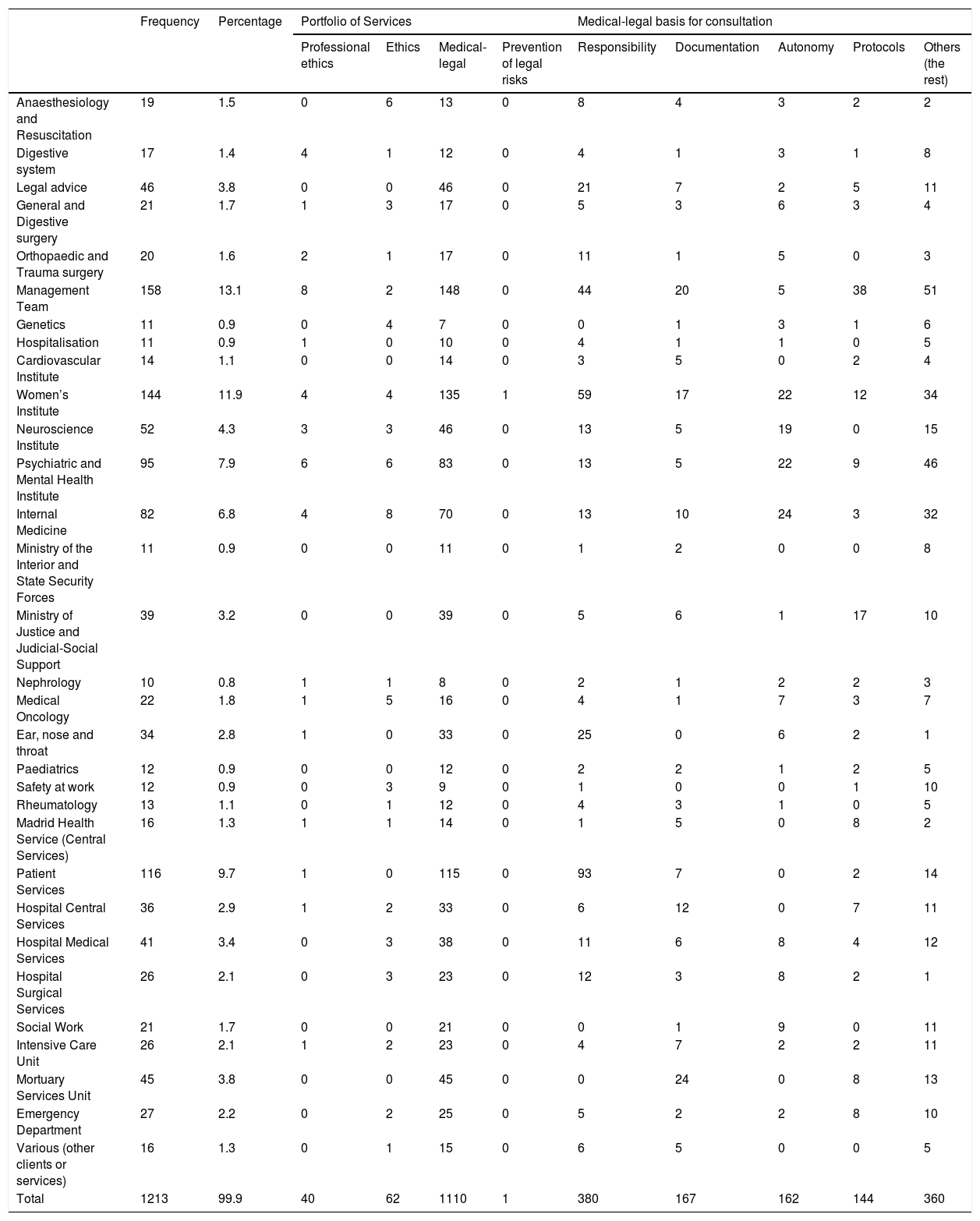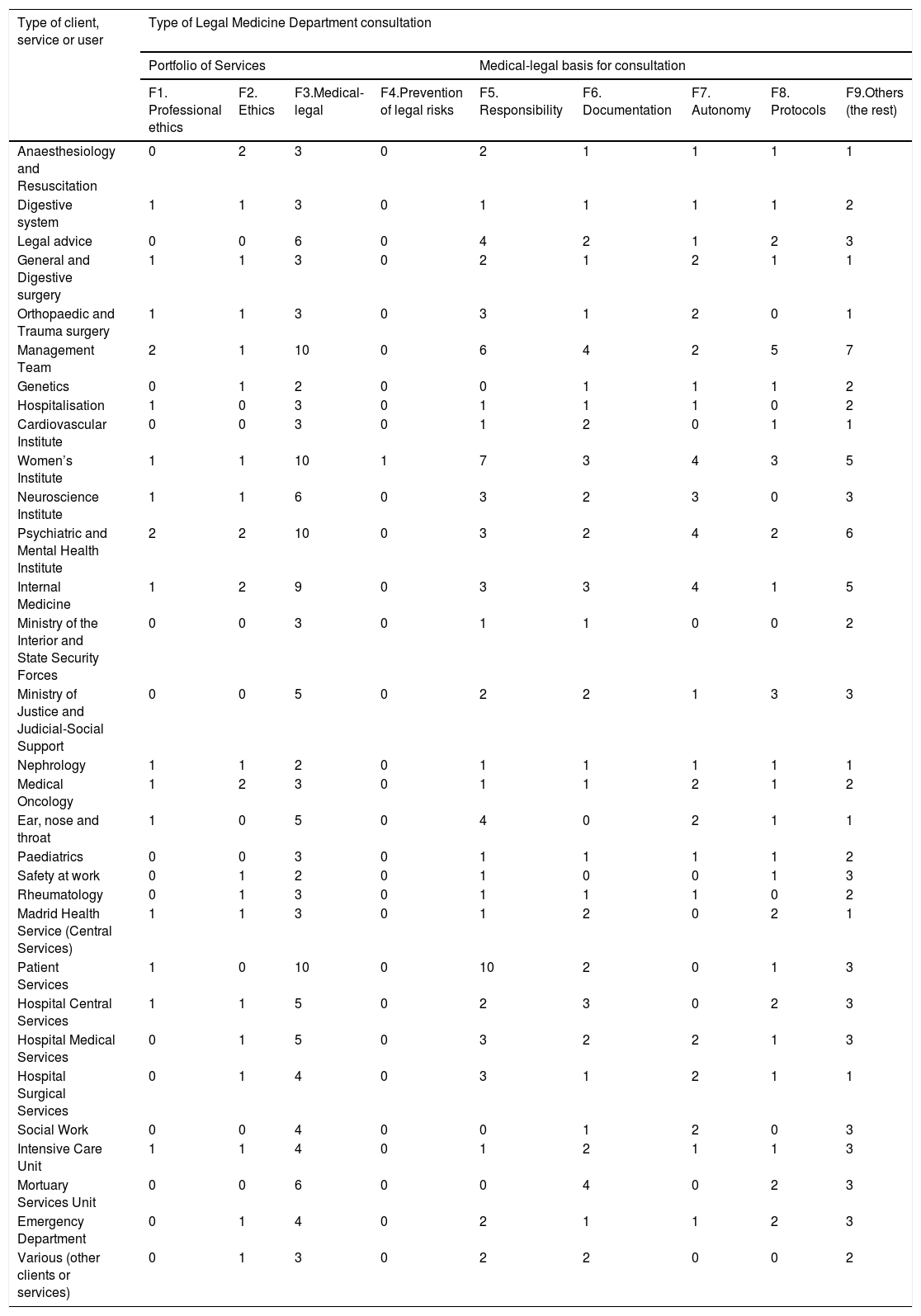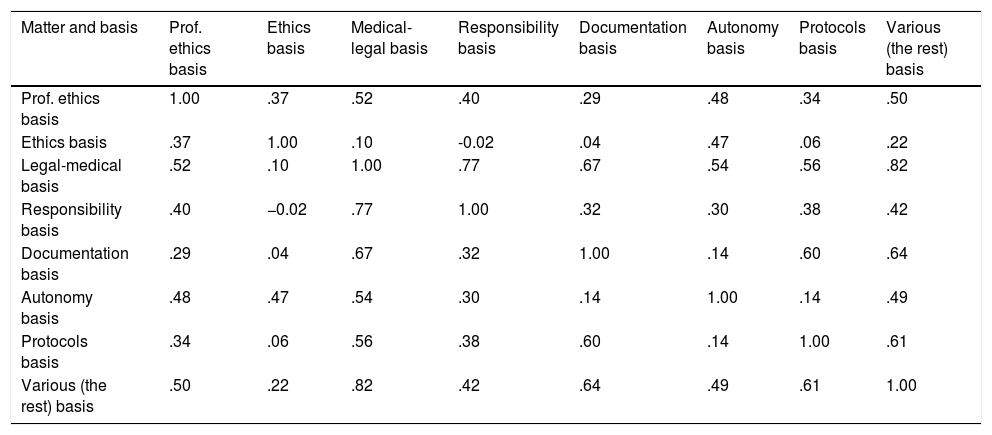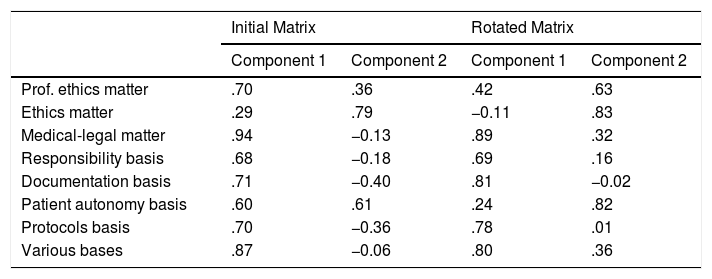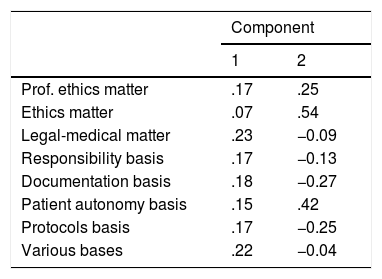The study of legal medicine approaches has been widely addressed in publications in the field of justice. However, the subject of hospital legal medicine services has been scarcely addressed in research; not attending to the importance of these services for the improvement of the legal risk management of health systems.
ObjectiveTo recognize the factorial structure of the benefits of the legal medicine service in a high-level hospital, among those seeking consultation for problems arising from the hospital's healthcare activity.
Material and MethodA descriptive cross-sectional study was carried out with a sample of 1213 files opened during the years 2007 and 2017. An exploratory factor analysis was performed by extraction of main components with varimax rotation.
ResultsThe average of records was 110.27 per year with a standard deviation of 39.51. The factorial analysis showed the two-dimensionality of the usefulness of the registry (letter of legal medicine services and medical-legal basis of the consultations), with the existence of two underlying factors that, added together, explained 68.04% of the total variance.
ConclusionsA simplified factor structure to two factors has been obtained with a high reliability of the registration questionnaire. Due to its registry nature and ease of use, it is advisable to consider its use in evaluating the demand for advice to the hospital legal medicine service by the different users who come for problems related to the usual activities of the hospital.
El estudio de los enfoques de la medicina legal ha sido ampliamente afrontado en publicaciones en el ámbito de la justicia. Sin embargo, la temática de los servicios de medicina legal hospitalaria ha sido escasamente abordada en investigaciones; no atendiendo a la importancia que tienen estos servicios para el perfeccionamiento de la gestión del riesgo legal de los sistemas sanitarios.
ObjetivoReconocer la estructura factorial de las prestaciones del servicio de medicina legal en un hospital de alto nivel, entre los demandantes de consulta por problemas derivados de la actividad asistencial del hospital.
Material y métodoSe realizó un estudio descriptivo transversal con una muestra de 1213 expedientes abiertos durante los años 2007 y 2017. Se efectuó un análisis factorial exploratorio por extracción de componentes principales con rotación varimax.
ResultadosLa media de expedientes fue de 110,27 por año con una desviación típica de 39,51. El análisis factorial mostró la bidimensionalidad de la utilidad del registro (carta de servicios de medicina legal y fundamento médico-legal de las consultas), con la existencia de dos factores subyacentes que, sumados, explicaron el 68,04% de la varianza total.
ConclusionesSe ha obtenido una estructura factorial simplificada a dos factores con una confiabilidad elevada del cuestionario de registro. Por su naturaleza registral y facilidad de empleo, es aconsejable considerar su utilización en la evaluación de la demanda de asesoramiento al servicio de medicina legal hospitalaria por parte de los diferentes usuarios que acuden por problemas relacionados con las actividades habituales del hospital.
Exploratory factor analysis is a technique used to reduce data dimensions to explain their correlations without losing too much information. It is based on a set of interrelated variables and the expression of other variables that cannot be observed directly, and then calculating factors by summarising information and clarifying the relationships between variables.1
The registry of a request for hospital legal medical consultation covers numerous variables simultaneously. Analysis is able to definitively synthesise all of these variables, favouring the proactive working of the service, driving training actions or highly specific forms of consultation, depending on the needs of the professionals in question.
Factorial analysis has an internal structure and dimensions that make it easier to understand.2–4 The registry was designed to identify the reasons for the most frequent consultations of the service. It measures the portfolio of legal medicine services and the medical-legal basis for consulting the same.5 Four areas of consultation are defined: professional ethics, ethics, medical-legal and the prevention of legal risks, the basis for which is broken down into professional responsibility, clinical and non-clinical documentation, patient autonomy, protocols and guides, among others (other consultations take place for a great many reasons). This instrument records absolute values within the response categories, identifying the consultation that took place. There is no scientific evidence for the existence of similar registries. The aim of this work is to recognise the factorial structure of the services offered by a hospital legal medicine department and its consultants for problems deriving from the activity of care.
Material and methodA transversal study was undertaken in the Hospital Clínico San Carlos, Madrid, using the records of the working of the legal medicine department from 1 October 2007 until 31 December 2017.5 This department is directly subordinate to the General Management of the Hospital. It was created in 1989 and it is under a specialist doctor in legal and forensic medicine, who has secretarial assistance.
The clients (departments or units) that could be evaluated were delimited and ranked according to the nature of the research.6,7 The registry for this research was undertaken ad post to form a homogeneous and unique system for all of the consultations, although there is a general registry of activity from 2007 on. Nine attributes of the service were studied, and these were coded from F1 to F9. They were awarded from 0 to 10 points on the basis of the absolute frequency of the consultations by different users, weighted in deciles. The factors evaluated are shown in Tables 1 and 2.
General characterisation of the sample obtained using the registry questionnaire on the demand for advice from the legal medicine consultancy department.
| Frequency | Percentage | Portfolio of Services | Medical-legal basis for consultation | ||||||||
|---|---|---|---|---|---|---|---|---|---|---|---|
| Professional ethics | Ethics | Medical-legal | Prevention of legal risks | Responsibility | Documentation | Autonomy | Protocols | Others (the rest) | |||
| Anaesthesiology and Resuscitation | 19 | 1.5 | 0 | 6 | 13 | 0 | 8 | 4 | 3 | 2 | 2 |
| Digestive system | 17 | 1.4 | 4 | 1 | 12 | 0 | 4 | 1 | 3 | 1 | 8 |
| Legal advice | 46 | 3.8 | 0 | 0 | 46 | 0 | 21 | 7 | 2 | 5 | 11 |
| General and Digestive surgery | 21 | 1.7 | 1 | 3 | 17 | 0 | 5 | 3 | 6 | 3 | 4 |
| Orthopaedic and Trauma surgery | 20 | 1.6 | 2 | 1 | 17 | 0 | 11 | 1 | 5 | 0 | 3 |
| Management Team | 158 | 13.1 | 8 | 2 | 148 | 0 | 44 | 20 | 5 | 38 | 51 |
| Genetics | 11 | 0.9 | 0 | 4 | 7 | 0 | 0 | 1 | 3 | 1 | 6 |
| Hospitalisation | 11 | 0.9 | 1 | 0 | 10 | 0 | 4 | 1 | 1 | 0 | 5 |
| Cardiovascular Institute | 14 | 1.1 | 0 | 0 | 14 | 0 | 3 | 5 | 0 | 2 | 4 |
| Women’s Institute | 144 | 11.9 | 4 | 4 | 135 | 1 | 59 | 17 | 22 | 12 | 34 |
| Neuroscience Institute | 52 | 4.3 | 3 | 3 | 46 | 0 | 13 | 5 | 19 | 0 | 15 |
| Psychiatric and Mental Health Institute | 95 | 7.9 | 6 | 6 | 83 | 0 | 13 | 5 | 22 | 9 | 46 |
| Internal Medicine | 82 | 6.8 | 4 | 8 | 70 | 0 | 13 | 10 | 24 | 3 | 32 |
| Ministry of the Interior and State Security Forces | 11 | 0.9 | 0 | 0 | 11 | 0 | 1 | 2 | 0 | 0 | 8 |
| Ministry of Justice and Judicial-Social Support | 39 | 3.2 | 0 | 0 | 39 | 0 | 5 | 6 | 1 | 17 | 10 |
| Nephrology | 10 | 0.8 | 1 | 1 | 8 | 0 | 2 | 1 | 2 | 2 | 3 |
| Medical Oncology | 22 | 1.8 | 1 | 5 | 16 | 0 | 4 | 1 | 7 | 3 | 7 |
| Ear, nose and throat | 34 | 2.8 | 1 | 0 | 33 | 0 | 25 | 0 | 6 | 2 | 1 |
| Paediatrics | 12 | 0.9 | 0 | 0 | 12 | 0 | 2 | 2 | 1 | 2 | 5 |
| Safety at work | 12 | 0.9 | 0 | 3 | 9 | 0 | 1 | 0 | 0 | 1 | 10 |
| Rheumatology | 13 | 1.1 | 0 | 1 | 12 | 0 | 4 | 3 | 1 | 0 | 5 |
| Madrid Health Service (Central Services) | 16 | 1.3 | 1 | 1 | 14 | 0 | 1 | 5 | 0 | 8 | 2 |
| Patient Services | 116 | 9.7 | 1 | 0 | 115 | 0 | 93 | 7 | 0 | 2 | 14 |
| Hospital Central Services | 36 | 2.9 | 1 | 2 | 33 | 0 | 6 | 12 | 0 | 7 | 11 |
| Hospital Medical Services | 41 | 3.4 | 0 | 3 | 38 | 0 | 11 | 6 | 8 | 4 | 12 |
| Hospital Surgical Services | 26 | 2.1 | 0 | 3 | 23 | 0 | 12 | 3 | 8 | 2 | 1 |
| Social Work | 21 | 1.7 | 0 | 0 | 21 | 0 | 0 | 1 | 9 | 0 | 11 |
| Intensive Care Unit | 26 | 2.1 | 1 | 2 | 23 | 0 | 4 | 7 | 2 | 2 | 11 |
| Mortuary Services Unit | 45 | 3.8 | 0 | 0 | 45 | 0 | 0 | 24 | 0 | 8 | 13 |
| Emergency Department | 27 | 2.2 | 0 | 2 | 25 | 0 | 5 | 2 | 2 | 8 | 10 |
| Various (other clients or services) | 16 | 1.3 | 0 | 1 | 15 | 0 | 6 | 5 | 0 | 0 | 5 |
| Total | 1213 | 99.9 | 40 | 62 | 1110 | 1 | 380 | 167 | 162 | 144 | 360 |
Score of weighted frequencies obtained using the registry questionnaire on the demand for advice from the legal medicine consultancy department.
| Type of client, service or user | Type of Legal Medicine Department consultation | ||||||||
|---|---|---|---|---|---|---|---|---|---|
| Portfolio of Services | Medical-legal basis for consultation | ||||||||
| F1. Professional ethics | F2. Ethics | F3.Medical-legal | F4.Prevention of legal risks | F5. Responsibility | F6. Documentation | F7. Autonomy | F8. Protocols | F9.Others (the rest) | |
| Anaesthesiology and Resuscitation | 0 | 2 | 3 | 0 | 2 | 1 | 1 | 1 | 1 |
| Digestive system | 1 | 1 | 3 | 0 | 1 | 1 | 1 | 1 | 2 |
| Legal advice | 0 | 0 | 6 | 0 | 4 | 2 | 1 | 2 | 3 |
| General and Digestive surgery | 1 | 1 | 3 | 0 | 2 | 1 | 2 | 1 | 1 |
| Orthopaedic and Trauma surgery | 1 | 1 | 3 | 0 | 3 | 1 | 2 | 0 | 1 |
| Management Team | 2 | 1 | 10 | 0 | 6 | 4 | 2 | 5 | 7 |
| Genetics | 0 | 1 | 2 | 0 | 0 | 1 | 1 | 1 | 2 |
| Hospitalisation | 1 | 0 | 3 | 0 | 1 | 1 | 1 | 0 | 2 |
| Cardiovascular Institute | 0 | 0 | 3 | 0 | 1 | 2 | 0 | 1 | 1 |
| Women’s Institute | 1 | 1 | 10 | 1 | 7 | 3 | 4 | 3 | 5 |
| Neuroscience Institute | 1 | 1 | 6 | 0 | 3 | 2 | 3 | 0 | 3 |
| Psychiatric and Mental Health Institute | 2 | 2 | 10 | 0 | 3 | 2 | 4 | 2 | 6 |
| Internal Medicine | 1 | 2 | 9 | 0 | 3 | 3 | 4 | 1 | 5 |
| Ministry of the Interior and State Security Forces | 0 | 0 | 3 | 0 | 1 | 1 | 0 | 0 | 2 |
| Ministry of Justice and Judicial-Social Support | 0 | 0 | 5 | 0 | 2 | 2 | 1 | 3 | 3 |
| Nephrology | 1 | 1 | 2 | 0 | 1 | 1 | 1 | 1 | 1 |
| Medical Oncology | 1 | 2 | 3 | 0 | 1 | 1 | 2 | 1 | 2 |
| Ear, nose and throat | 1 | 0 | 5 | 0 | 4 | 0 | 2 | 1 | 1 |
| Paediatrics | 0 | 0 | 3 | 0 | 1 | 1 | 1 | 1 | 2 |
| Safety at work | 0 | 1 | 2 | 0 | 1 | 0 | 0 | 1 | 3 |
| Rheumatology | 0 | 1 | 3 | 0 | 1 | 1 | 1 | 0 | 2 |
| Madrid Health Service (Central Services) | 1 | 1 | 3 | 0 | 1 | 2 | 0 | 2 | 1 |
| Patient Services | 1 | 0 | 10 | 0 | 10 | 2 | 0 | 1 | 3 |
| Hospital Central Services | 1 | 1 | 5 | 0 | 2 | 3 | 0 | 2 | 3 |
| Hospital Medical Services | 0 | 1 | 5 | 0 | 3 | 2 | 2 | 1 | 3 |
| Hospital Surgical Services | 0 | 1 | 4 | 0 | 3 | 1 | 2 | 1 | 1 |
| Social Work | 0 | 0 | 4 | 0 | 0 | 1 | 2 | 0 | 3 |
| Intensive Care Unit | 1 | 1 | 4 | 0 | 1 | 2 | 1 | 1 | 3 |
| Mortuary Services Unit | 0 | 0 | 6 | 0 | 0 | 4 | 0 | 2 | 3 |
| Emergency Department | 0 | 1 | 4 | 0 | 2 | 1 | 1 | 2 | 3 |
| Various (other clients or services) | 0 | 1 | 3 | 0 | 2 | 2 | 0 | 0 | 2 |
The reliability of the registry obtained a Cronbach’s alpha8 of 0.84, guaranteeing the level of reliability of the measurement scale and the degree of covariation between established clients, under the assumption that they had a positive correlation between them, because they measure the characteristics and properties of a common construct.9 The suppositions for the application of factorial analysis are fulfilled: normalcy, linearity, homoscedasticity, a low matrix determinant, high correlations and sample homogeneity.10,11 All of the variables play the same role and no dependent variables are defined.
A sample correlation matrix was generated among all of the variables considered, and a series of tests were obtained which indicate the relevance of the factorial analysis: a low matrix determinant (.0042), confirming a high degree of lineal correlation between the original variables and permitting matrix rotation; the Kaiser–Meyer–Olkin (KMO) test of sample suitability was acceptable (.62) and Bartlett’s sphericity test was highly significant (P < .001) showing that a matrix is factorizable.12,13
Extraction of the initial factors from the correlation matrix followed the method of Principal Component Analysis (PCA).14 This method uses Pearson’s matrix and the Varimax Rotation was selected to facilitate the interpretation of the solution obtained. The PCA repeatedly refines the matrix of correlations between variables, obtaining the different factors that underlie the data. A model is produced that has as many factors as there are variables included in the analysis. Each factor is equivalent to a weighted sum of the values which a client has for each variable. It finds the underlying component that explains the greatest amount of variance in the correlation matrix, and it subtracts it from the original matrix; it then finds a second factor which explains the maximum proportion of the remaining variance, and so on. The amounts of variance are denominated autovalues.12 For the purposes of this study, only those factors which are able to explain a total amount of variance equal to or greater than 1 have been extracted, because they explain more variance than an original variable (Kaiser rule).15
Model validity examined goodness of fit to discover the quality of the solution obtained, comparing the initial correlation matrix with the matrix generated using the latent variables.
Finally, the resulting factors were interpreted, assigning them names considering the original variables included in each factor. The SPSS 25.0 program was used for data analysis.
ResultsA total of 1213 files were opened from 2007 to 2017, with an average of 110.27 per year (standard deviation 39.51). Table 1 shows that the highest proportion of consultations of the legal medicine department were by the Management Team (13.1%), The Women’s Institute (11.9%) and Patient Services (9.7%). Consultations by the following departments amounted to less than 1% of the total: Nephrology (.8%), Genetics, Hospitalisation, Paediatrics, Work Safety and those by the Ministry of the Interior and State Security Bodies (.9% for all of them). Table 2 shows the weighted scores for each type of client consultation and for the services portfolio, as well as the basic reason for consultation. The clients who obtained the highest scores were the Management Team, the Women’s Institute, Patient Services and the Institute of Psychiatry and Mental Health.
Table 3 shows the correlation matrix between the variables, and Table 4 shows the value and percentage of variation it is able to cause for each one of the components. Only two factors were extracted, with an intrinsic value higher than 1. The value of the first component was 3.99, with 49.84% explained variance. The second component had a value of 1.46 and 18.21% explained variance. The accumulated percentage of variance in both components amounted to 68.04%.
Matrix of correlations between the variables.
| Matter and basis | Prof. ethics basis | Ethics basis | Medical-legal basis | Responsibility basis | Documentation basis | Autonomy basis | Protocols basis | Various (the rest) basis |
|---|---|---|---|---|---|---|---|---|
| Prof. ethics basis | 1.00 | .37 | .52 | .40 | .29 | .48 | .34 | .50 |
| Ethics basis | .37 | 1.00 | .10 | -0.02 | .04 | .47 | .06 | .22 |
| Legal-medical basis | .52 | .10 | 1.00 | .77 | .67 | .54 | .56 | .82 |
| Responsibility basis | .40 | −0.02 | .77 | 1.00 | .32 | .30 | .38 | .42 |
| Documentation basis | .29 | .04 | .67 | .32 | 1.00 | .14 | .60 | .64 |
| Autonomy basis | .48 | .47 | .54 | .30 | .14 | 1.00 | .14 | .49 |
| Protocols basis | .34 | .06 | .56 | .38 | .60 | .14 | 1.00 | .61 |
| Various (the rest) basis | .50 | .22 | .82 | .42 | .64 | .49 | .61 | 1.00 |
Total variance explained by the components.
| Initial autovalues | Squared extraction saturation sums | |||||
|---|---|---|---|---|---|---|
| Component | Total | % variance | % accumulated | Total | % variance | % accumulated |
| Prof. ethics matter | 3.99 | 49.84 | 49.84 | 3.99 | 49.84 | 49.84 |
| Ethics matter | 1.46 | 18.21 | 68.04 | 1.46 | 18.21 | 68.04 |
| Medical-legal matter | .88 | 11.03 | 79.07 | |||
| Responsibility basis | .58 | 7.28 | 86.35 | |||
| Documentation basis | .43 | 5.33 | 91.68 | |||
| Autonomy basis | .39 | 4.87 | 96.55 | |||
| Protocols basis | .24 | 2.95 | 99.50 | |||
| Various (the rest) basis | .04 | .50 | 100.00 | |||
Table 5 shows the initial component matrices and the results following rotation. As may be seen, factor 1 contains the legal medicine matter, the basis documentation, others (the rest), protocols and responsibility. It is associated the most with the legal medicine matter (.94 and .89) and the least with the ethical matter (.29 and −0.11). The majority of the variables which include factor 1 are mainly associated with the “portfolio of services” dimension. Factor 2 is associated more with the ethical matter (.78 and .83) and with the basis of patient autonomy (.61 and .82).
Matrix of components and matrix of rotated components.
| Initial Matrix | Rotated Matrix | |||
|---|---|---|---|---|
| Component 1 | Component 2 | Component 1 | Component 2 | |
| Prof. ethics matter | .70 | .36 | .42 | .63 |
| Ethics matter | .29 | .79 | −0.11 | .83 |
| Medical-legal matter | .94 | −0.13 | .89 | .32 |
| Responsibility basis | .68 | −0.18 | .69 | .16 |
| Documentation basis | .71 | −0.40 | .81 | −0.02 |
| Patient autonomy basis | .60 | .61 | .24 | .82 |
| Protocols basis | .70 | −0.36 | .78 | .01 |
| Various bases | .87 | −0.06 | .80 | .36 |
Table 6 shows the score coefficients of the components that were extracted from the original variances and the percentages of total variation which they are able to explain, together with the establishment of the weightings that have to be applied to each standardised variable to obtain the real value of the factors. The two real factors that were extracted are therefore:
Factor 1 = 0.17·z professional ethics + 0.07·z ethics + 0.23·z medical-legal + 0.17·z responsibility + + 0.18·z documentation + 0.15·z autonomy + 0.17·z protocols + 0.22·z various
Factor 2 = 0.25·z professional ethics + 0.54·z ethics - 0.09·z medical-legal 0.13·z responsibility - 0.27·z documentation + 0.42·z autonomy 0.25·z protocols - 0.04·z various
DiscussionThe findings show that factorial analysis is a useful tool for exploring the factorial composition of the legal medicine department registry of consultations, identifying factors which explain a variety of consultations. The high reliability and bidimensional factorial structure of the registry reduce the original variables to two factors which explain more than 68% of total variance:
One factor is characterised by the type of consultation in the portfolio of services for medical-legal matters and a diverse medical-legal basis, which explains 49.84% of the variance. This factor gives a positive sign to all of the “portfolio of services” and “medical-legal basis” variables. It corresponds to the type of client who consults for medical-legal matters, a range of bases (autopsy, judicial aid, confidentiality, the conflictive nature of a patient or family member, custody, family environment, work environment, identification, previous hearings, mistreatment, regulations, data protection, suicide, toxicology or violence) and documental matters. To a lesser degree, the reasons for consulting consist of responsibility, protocols and guides, matters involving professional ethics and patient autonomy, with little consultation due to ethical matters.
The other factors is characterised by a type of consultation with a medical-legal basis, ethical and about patient autonomy, which alone explains 18.21% of the variance. This factor gives a positive charge to the ethical matters and professional ethics variables, as well as those associated with the basis of patient autonomy; however, the other correlations have an inverse association and chiefly correspond to consultations due to professional ethics and those based on documentation, protocols and guides.
For practical purposes it would be recommendable for professionals themselves to request advice by framing their doubts in terms of one of the medical-legal bases for the same, as this could lead to better adaptation to the real nature of care in clinical activity.
The Hospital Registry of Legal Medicine Services is an instrument for recording data that is easy to complete and useful as a tool to summarise the advice given to its users. The authors of this work propose a registry that would show the validity of its criterion in the future by means of the use of confirmative factorial analysis, which could be evaluated in future studies.
Our main limitation is that although consultations for advice vary widely and are numerous, from many different departments, exploratory factorial analysis reduces them very significantly to two factors. It would be of interest and recommendable to undertake a qualitative study of this wide variability in advice.
The bifactorial result of this study does not exclude the existence of other solutions in the registry of the activity of the department in other centres, although our proposal can be extrapolated.
What is known about the subject? This multiple regression technique has been widely used in many areas of psychology, aetiology and sociology. However, it has not been used so often in public health and medical administration studies. The application of epidemiological methodology in the evaluation of health services’ management means that measuring instruments and questionnaires are increasingly necessary, and these require particular means of validation to be used.
What does this study add to the literature? This example of the use of factorial analysis in the study of the dimensions of this registry system has the aim of showing the increasing importance of including multivariate analysis techniques in research work in legal medicine, public health and medical management in general.
Conflict of interestsThe authors have no conflict of interests to declare.
Please cite this article as: Santiago-Sáez A, García-Martín ÁF, Olivares-Pardo E, Liaño-Riera M, Labajo-González E, Perea-Pérez B. Balance del asesoramiento médico legal hospitalario mediante análisis factorial exploratorio. Rev Esp Med Legal. 2021;47:105–111.




